Galaxy clusters and large scale structure
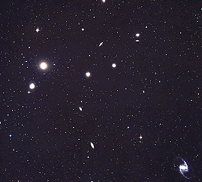
Fornax is a small cluster of spiral and elliptical galaxies near our local group
Groups and clusters of galaxies
Galaxies are preferentially found in groups or larger agglomerations called clusters. The Local Group consists of our own galaxy, the larger spiral galaxy Andromeda (M31) and several smaller satellites, including the Large and Small Magellenic Clouds.
Regular clusters have a concentrated central core and a well-defined spherical structure. These are subdivided according to their richness, that is, the number of galaxies within 1.5 Mpc of the centre (known as the Abell radius). Typically, they have a size in the range 1-10Mpc and a mass M ~ 1015 solar masses (one followed by 15 zeros, that is, a million billion suns). The Coma cluster is a very rich cluster with thousands of ellipticals inside the Abell radius.
Irregular clusters have no well-defined centre, a similar range of sizes, but they are generally poorer with a mass of approximately 1012 - 1014 solar masses (i.e. a thousand to a hundred thousand million suns). An example is the nearby Virgo cluster.
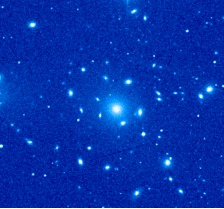
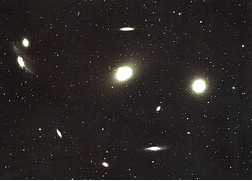
Figure 1. (left) The central region of the Coma cluster populated with large elliptical galaxies. This is one of the densest known regions on this scale in the Universe
Figure 2. (right) Virgo, an irregular cluster, is the nearest large cluster of galaxies
Large-scale structures
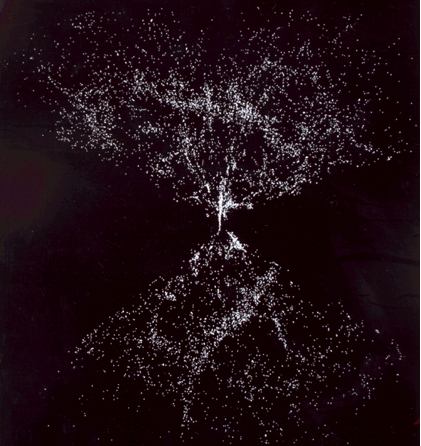
The CfA survey showing large scale structures out to a distance of 150Mpc, that is, about 2% of the distance to the edge of the observed Universe. Galaxy positions are plotted as white points and large filamentary and sheet-like structures are evident, as well as bubble-like voids (CfA)
Superclusters: These usually consist of chains of about a dozen clusters which have a mass of about 1016 solar masses (ten million billion suns). Our own Local Supercluster is centred on Virgo and is relatively poor having a size of 15Mpc. The largest superclusters, like that associated with Coma, are up to 100Mpc in extent. The system of superclusters forms a network permeating throughout space, on which about 90% of galaxies are located.
The Great Attractor: Measurements of peculiar velocities (deviations away from the Hubble flow, the general outward movement of galaxies away from us due to the expansion of the Universe) are achieved by comparing redshifts and galactic distance indicators. These have revealed enormous coherent motions on scales in excess of 60Mpc. Consistent with these flows, our own galaxy is moving at about 600km/s towards a distant object dubbed the 'Great Attractor'. This lies at a distance of 45Mpc and has a mass approaching 5x1016 solar masses.
Voids, sheets & filaments: Deep redshift surveys reveal a very bubbly structure to the Universe with galaxies primarily confined to sheets and filaments. Voids are the dominant feature and have a typical diameter of about 25Mpc. They fill about 90% of space and the largest observed, Bootes void, has a diameter of about 124Mpc. Other features that have been observed are the 'Great Wall', an apparent sheet of galaxies 100Mpc long at a distance of about 100Mpc.
Deep field surveys
A particularly exciting recent development in the study of large-scale structure has been the advent of very deep galaxy surveys, notably those currently being made by the Hubble Space Telescope. These images (below) show galaxies just a couple of billions years after the Big Bang. One of the remarkable puzzles presented by this work is that galaxies appear to form earlier than predicted in most theoretical models.
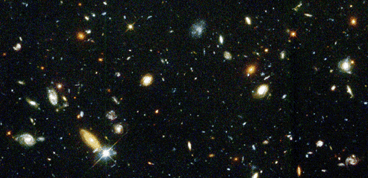
The deep field image of galaxies is accompanied by an animation showing the position in the sky and the extent of the telescope's magnification. (HST) Click here to see the HST movie
Observation has shown that normal matter, such as makes galaxies, only makes up about 4% of the total mass of the Universe. Click here to find out more about dark matter and the implications surrounding it.
